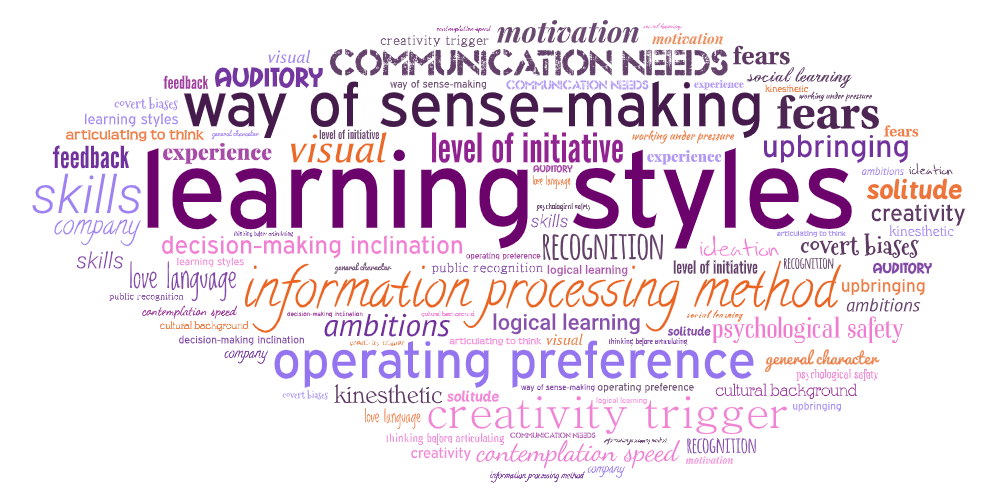Image by Freepik
Diversity and inclusion are not solely about race, religion, age, or LGBTQ+.
Well, not exclusively about these factors.
What is diversity and inclusion really about?
I was inspired to write about diversity and inclusion after reading yet another article emphasising mentioned aspects over others. It’s easier to identify skin colour, religious or sexual/gender preferences—our bias often leads us to prefer what’s visibly apparent.
However, when discussing diversity and inclusion, we should also consider
- different learning styles,
- information processing methods,
- ways of sense-making,
- operating preferences,
- creativity triggers,
- communication needs,
- contemplation speed,
- and decision-making inclinations.
Additionally, we should explore factors like the level of initiative, elements that create or jeopardise psychological safety based on upbringing, preferred love language, means and methods of motivation and recognition, covert biases, fears, ambitions, skills, experience, cultural background, or general character.
Examples of these differences include
- the inclination to introversion or extraversion,
- preferring logical or social learning,
- acquiring information visually or auditorily,
- articulating to think or thinking before articulating,
- needing solitude or company to unleash creativity,
- working well or worse under pressure,
- deciding on the spot or sleeping on it,
- wanting to spar ideas before putting them into action versus getting something done and collecting feedback,
- ideating freely in a group or preferring to think everything through before presenting,
- wanting or fearing public recognition, etc.
Psychologists and social scientists have studied such differences and personal preferences for years, and their research results don’t show any decline in the variety of ways of operating. Instead, the picture is becoming more colourful, not to say messier. It is getting messier for organisations and people themselves. The need to know thyself is increasingly important. As our brain is wired to notice something being wrong much more sharply than to what is well and right. We may sense that something is off – our whole self is not invited or included – but may not be equally able to put our finger on it or state what we truly need, how “right” looks like, and what it really means.

For example, I have a fast creativity. I can shoot ideas on the spot. This can lead people to think that I’m also quick to take action. But I’m a rather deep thinker. This means that I need time to think things through before I take action. So, unless you understand that my creativity and contemplation have different paces, you can get confused, even be disappointed, when you don’t see me jumping into action and delivering tomorrow. I’ve experienced a lot of stress due to these two different operating modes. One or the other has been neglected in different roles.
Most people operate in many different modes. We are all multi-talented and versatile. Sometimes our versatility can even be confusing for ourselves, not to mention our colleagues or teams. But this is what diversity and inclusion are really about. We need this multitude of talents and preferences in organisations because our clients and customers are as diverse. The better you understand diversity in your organisation, the better you also understand your diverse clientele.
It is not about considering some minority.
It is about considering the majority.
5 principles for diversity and inclusion
The myriad of differences makes it literally impossible to anticipate it all. There has to be another way. And this other way consists of five principles that need to be applied day in, day out. These principles are awareness, curiosity, focusing on benefits, communicating rationale behind decisions, and staying alert.
Awareness:
First, get to know yourself, without judgment. How do you really operate? How and in which conditions do your talents emerge? What really affects you and your preferences? What biases are dominant for you?
Then accept that you are a minority. Most people operate differently from you. Only very few people get you instinctively, and you get very few people spontaneously. Always keep in mind that there is so much more to the people you work with than what you know. Consciously train yourself to notice, when you jump into conclusions so that you can train yourself to withhold biased judgment.

Curiosity:
Be curious about others, their preferences, talents, and ways. Have the courage to ask about their preferences, operating modes, fears, and motivations. Make an effort to get to know your people.
Sometimes we are afraid to learn about someone’s different preferences, because we don’t know what to do with the information received. In such situations, revert to asking more great questions to deepen your understanding and listen to when, where, and how they want to be included and considered. If your intention is appreciative of diversity, your questions will land well. If you come from a place of judgment or manipulation, you will have killed diversity before you can even start taking any advantage of it.
Focus on the benefits:
Our brain is wired to be cautious of the unknown or different. Our brain is also wired to get used to everything over a period of time. Take advantage of the brain’s inclination to habituate. Expose yourself to personal differences. The more you seek diversity, the more your brain habituates to it.
Also, focus on the benefits of any individual difference. How is this useful to them, you, your team, and your organisation? Help others see their peculiarities as talents instead of shortcomings. Also, be flexible in your expectations. If you learn to see advantage in diversity, you can be sure to have your expectations exceeded in unexpected ways.
Communicate rationale behind decisions:
Decision making is a difficult process. Good decision-making includes the opinions of relevant stakeholders. Not all stakeholders are relevant in every decision. The first difficulty is deliberating who are relevant stakeholders; the second difficulty is explaining why others aren’t. But when your intention is to benefit everyone, and you are openly communicating both the decision, the process of decision-making, and the rationale behind it, you cannot really go wrong.
For example, when designing a new office space, men’s opinion about whether or not there should be a bidet in each women’s toilet is not relevant. Men are stakeholders as they also use the office space, but their opinion on this question is irrelevant. And even if some men feel left out, you can rationalize the decision-making process.
Stay alert:
Even with the best intentions, you sometimes mess up. You unintentionally leave someone out. Someone feels left out no matter what you do or don’t do. Stay alert to these voices and concerns, ask for feedback and additional input. Listen. Reiterate your intention. If the complaints are justified, adjust processes, policies, proposals, procedures as needed. Try to reduce politics and limit procedures required to make diversity-supporting adjustments. The more agile and flexible you are, the more you will benefit from diversity.
To conclude, diversity and inclusion are about considering our human versatility. It is not about considering some minority; it is about considering the majority. You can close yourself to diversity, but then you close yourself to the majority. You don’t have to do diversity, but it presents an opportunity. Lost opportunities are a source of regret both for individuals and organizations.
What other principles and practices do you recommend to ensure diversity and inclusion? Share in comments!